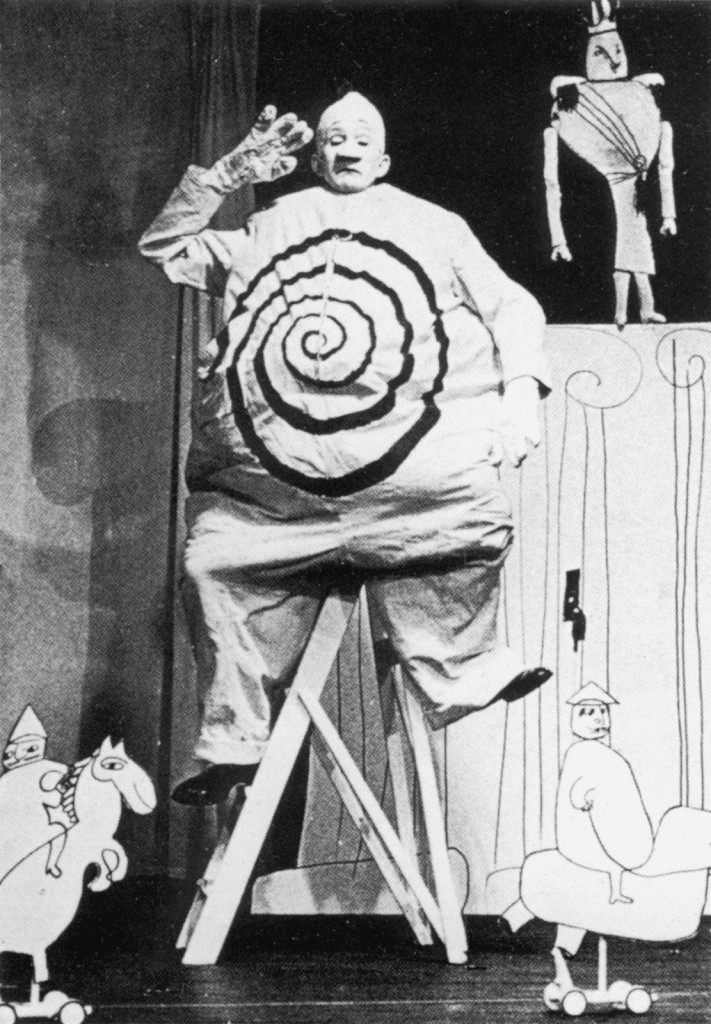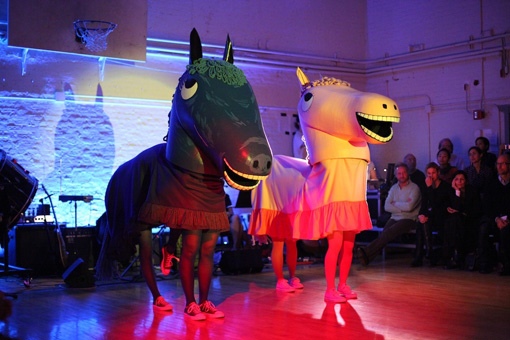The social delinquent and adolescent rebel as artistic archetype. As long as one keeps rebelling, raging, one guarantees they can never change and grow old. Grow into maturity. It became one of the pathologies of the romantic movement, to die young instead of fading into inglorious participation in the larger society. It became part of the leisure class phenomenon. The distinction, luxury and status to fester in infantilism implied a wealth and means not available to the commoner to indulge in adolescent malaise and fetishized youthful unhappiness.

Alfred jarry. Ubu Roi. The first word is merde. It's used 33 times in the play. A masonic level of .... Read More:http://chaudron.blogspot.com/2010/04/marionetteatern-stockholm-kung-ubu.html
The romance of the unstable, precarious and impatient. There is an element of narcissism in this glorification of the immature mind that seems to cater to a widespread need for disavowal, to condone and enjoy, to taste the completely artificial flavor of the concept of youthful innocence. Effectively, institutional immaturity is an industry, a business model, whether golden ager Michael Moore in ball cap and sneakers out of a Rockwell cover, or parents throwing temper tantrums there is almost a conscious act to engage immaturity in an embalming act within the myth of itself where the immature mind is somehow seen as crucial to unlocking the past as key to civilization’s advancement or demise.

---Provocateur and performer Paul McCarthy's giant solo show is leaving a mucky trail all over town, we wade through his fun-filled wild kingdom featuring ex-presidents porking pigs There's no more overblown or ambitious exhibition on anywhere at the moment. 'The King, The Island, The Train, The House, The Ship' is Paul McCarthy's multi-venue takeover of Hauser & Wirth's London galleries, rounded off by two more parts, 'The Dwarves, The Forests', in New York. Long regarded as the grandfather of performance art, this LA legend never knowingly does under-the-top, whether painting with his penis in 1974 or smearing ketchup and chocolate where the sun don't shine in live-action happenings such as 'Rocky' (1976) or the 'Santa Chocolate Shop' (1997).--- Read More:http://www.timeout.com/london/art/event/245497/paul-mccarthy
This originated in Europe as part and package of the romantic movement: the adolescent as phenomenon. Within the American context, this took the form of the “teenager” , a singular marketing concept to build a narrative around and cash in on the baby boom. Essentially, is an artificial construction. The first time the expression teenager was trotted out like a debutante was in the late 1930′s.Something like Eward Bernays and his exploitation of women smoking as “torches of freedom,” this also smelled like a rat. It is not inherently natural for people of this age to be destructive and antagonistic towards elders. There are dysfunctionals, but much is an identity issue, buying into teen ideology, a corporate creation that promotes “individualism” and self-expression- liberty, freedom- as consumption values. As if using a Tampax provides the same creative liberating energy that guided Da Vinci.

---Mike Kelley art--- Read More:http://www.fadwebsite.com/2012/02/02/artist-mike-kelley-found-dead-in-los-angeles/
Donald Kuspit ( see link at end):These signs of prolonged adolescence are self-evident in the key avant-garde figures of Rimbaud, Jarry and Lautréamont — role models for the Surrealists, as André Breton said. All were adolescent in spirit — Rimbaud was literally an adolescent when he wrote his poems — and none lived long beyond chronological adolescence. I will argue that the emergence of the avant-garde is correlate with and inseparable from the emergence of “adolescence” as a concept — invented by the American psychologist G. Stanley Hall in 1898 — and that to be avant-garde means to be an extremely anxious adolescent. Adolescence and avant-gardism are correlates, as the historical facts suggest. Avant-garde artists were literally adolescents, and adolescents had avant-garde spirit, that is, they were as irreverent and rebellious as avant-garde artists. Avant-gardism is the acting out, through art, of contempt for authority and established tradition, in an attempt to discredit and replace it. The rebellion is usually carried out in the name of a new order, but there is no clear conception of it, and in fact it is unrealistic and naive. Like the French and Russian Revolutions, the avant-garde revolution becomes a totalitarian reign of adolescent terror — a more brutal tyranny than the tyranny it replaced, just as the Communist tyranny was more brutal than the Czarist tyranny….
…Perhaps the first event that signaled the privileging of adolescence was the publication of Rousseau’s Emile in 1762. It introduced the scandalous idea that puberty was “a second birth.” Its characteristics were “a change of temper, frequent outbursts of anger, a perpetual stirring of the mind.” Shortly afterwards, in 1774, Goethe’s The Sorrows of Young Werther appeared. Its adolescent hero became a romantic role model. Werther had the “sacred and inspiring ability to create new worlds,” but, as Jon Savage writes, he was subject to “extreme mood swings . . . sensitivity to social slights . . . and self-pitying rhetoric.” Finding no way out of this emotional trap — unable to resolve his conflicts — he committed suicide. Unable to grow beyond his adolescent way of feeling and thinking, with its unrealistic expectations from the world and himself, he dead-ended in premature death, in effect confirming his arrested development. Read More:http://www.artnet.com/magazineus/features/kuspit/kuspit8-17-07.asp

---being to discover what linguistic messages or images convey manipulative information which is picked up by teenagers creating in them the need to obtain certain products. I would like to highlight that the most manipulative advertisements are directly aimed at girls (being aware that, at first sight at least, the magazines used in order to gather the main advertising corpus are aimed at teenagers in general) rather than boys, as they tend to be better potential customers and more easily manipulated according to several authors like Kilbourne (1999). The magazines studied here are aimed solely at girls, I was not able to find a magazine aimed solely at teenage boys - which, in my view, shows that the feminine world is more likely to be persuaded. We should try to make our teenagers, especially girls, immune to advertising dangers since, as Kilbourne (1999) argues, much of advertising power comes from the belief that advertising does not affect us. The most effective kind of propaganda is that which is not recognized as propaganda. Because we think that advertising is silly and trivial, we are less on guard, less critical, than we might otherwise be. Read More:http://www.upv.es/dla_revista/docs/art2011/02_RDLAn6_AlcantudDiaz_Maria.pdf image:http://adsoftheworld.com/forum/40932
Nihilism, permanent revolution. To some extent, continuous upheaval is the mark of a healthy society.
status-quo in America is not tolerated for extended periods. But, it is also as credo of post-modern art, and uneasy parallel with the “creative destruction” and permanent revolution found in the worst excesses of the market economy, where tradition, and memory are subject to revision or simply discarded.The so-called shock of the new is too often an illusion followed by a sense of betrayal and abandonment.ADDENDUM:
Kuspit: Interestingly, Balint gives us a clue as to why avant-garde movements quickly replace one another. If “the tension” in a narcissistic state is “so great” that it “tends to break down, disintegrate spontaneously even without any forceful attack from outside,” as Balint writes, then narcissistic avant-gardism cannot help but repeatedly break down, suggesting its creative inadequacy. Clearly this is connected to its failure to respect the human object, even address it, as pure art’s indifference to the human object — it is not altogether clear that pure art’s transcendence can be distinguished from indifference — indicates.Read More:http://www.artnet.com/magazineus/features/kuspit/kuspit8-17-07.asp








 COMMENTS
COMMENTS



